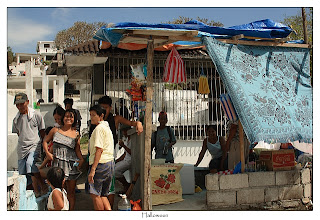Young lads getting on with the chores.
Paint touch up.
Mayhem at the Cemetery entrance.
Protection from the sun.
Getting stuck in.
Delicate touch.
No one spared the chores.
Nearly finished.
Larger job.
Water for flowers.
The most popular day is however “All Saints Day”. Where families spend their whole day in the cemetery bringing flowers and lighting candles for their departed loved ones. They bring food as well, not just for themselves but also for relatives and friends who visit and pray for their loved ones. Some take this as an opportunity to reunite and to bond, and so they bring things such as radio, cards, guitars, etc. for the enjoyment of the whole family. Main entrance.
Candles.
High up on the hill.
You have to give it to Filipinos for finding joviality, a sense of fun and something to celebrate even in the most sombre and gloomy of situations. Always up for a celebration when big gatherings of relatives are present, be it for a baptism, wedding and funeral or, in this case, honouring the dead. Filipino families being quite extended, these gatherings are occasions where they meet 'long lost kin' and are updated on one another’s life. In many cases people who bring food to the tombs don’t just bring food for their own consumption. They also set aside portions as offerings for the dead, believing that somehow the dead still have a way of partaking in the earthly feast.
Drinks and snack time.
Not in the public cemetery.
Subic bay from boot hill.


















0 comments:
Post a Comment